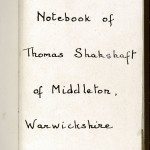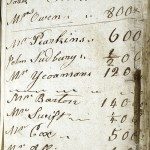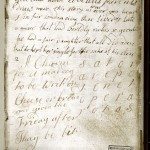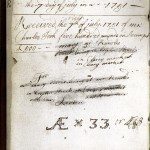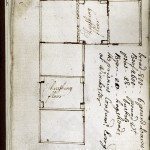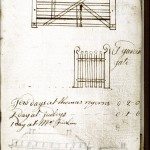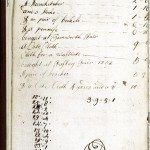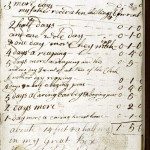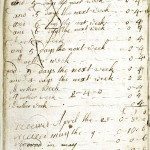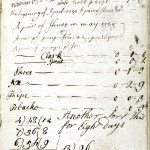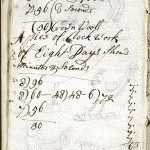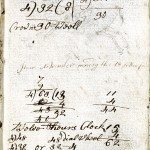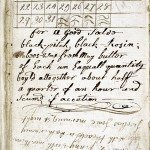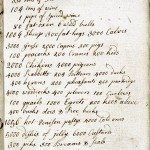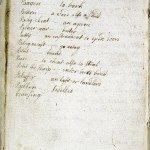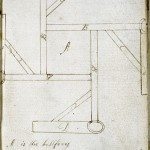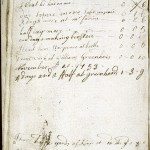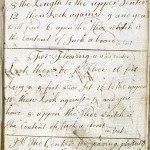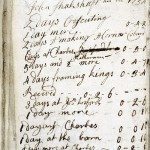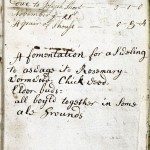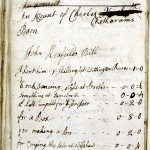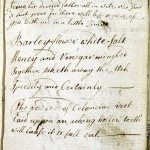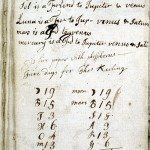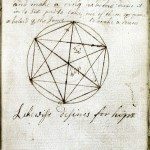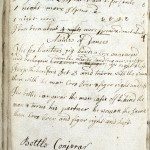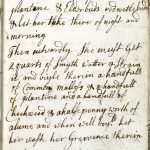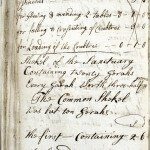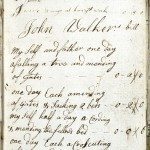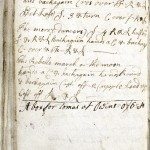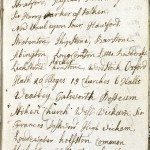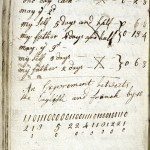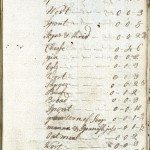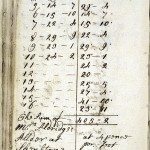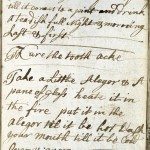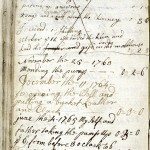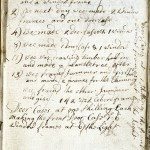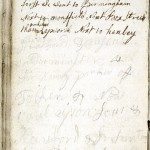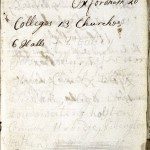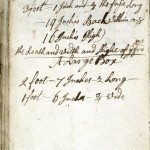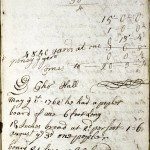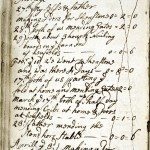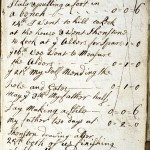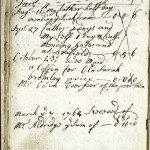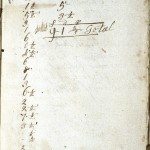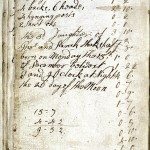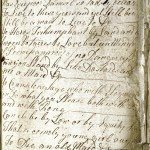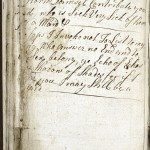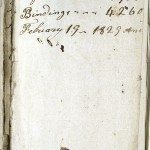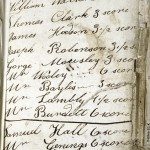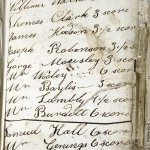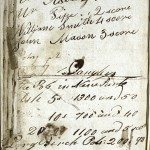The Notebook of Thomas Shakshaft – Part One
Notebook of
Thomas Shakshaft
of Middleton, Warwickshire
Lived 1731 – 1821
(Written during the period 1751 – 1765)
Summary
Thomas Shakeshaft or Shakshaft (1731-1821) was a carpenter who lived in Middleton, Warwickshire. His notebook in Birmingham City Archives is a very rare example of written record produced by a skilled working man in the late eighteenth century. A selection of images with transcripts by Bob Whorwood, a descendant of Thomas Shakeshaft has been placed on the Revolutionary Players website. A limited edition of the notebook has been published. It contains detailed introductory material by Bob Whorwood based on research into Thomas Shakeshaft’s life. The text below is selected from this material.
—- —- —-
The Notebook was donated to Birmingham City Archives in 1944 by Mr. E. T. Griffiths, manager of the Ritz Cinema in Cheltenham, and was rebound in 1946. This front sheet was clearly written at that time. The Birmingham Library accession number is 55664711R41.
Two points arise. Firstly the spelling of the name here does not have a central ‘e’. There is an inconsistency in this regard in what Thomas wrote as he included this ‘e’ rather erratically. However, there seems to be total consistency elsewhere. The tombstone of his son Robert junior, a tapestry produced by his granddaughter Elizabeth, parish and census records as well as records of work for the Middleton Estate all use the central ‘e’. Further, records of Thomas’s father Robert, also a carpenter of Middleton and his grandfather John predating this notebook by many years, consistently show use of the middle ‘e’. It seems reasonable to assume that we should do so now and use the name Shakeshaft. Thomas himself signed his name with the central ‘e’ when he was a witness to a marriage in October 1764.
The dates on the frontispiece, obviously inserted in 1946 during rebinding, are misleading. Certainly entries in the book cover the period 1751 to 1828 but Thomas died in 1821 and entries after that date are not in his handwriting. These “rogue” entries represent less than 5% of the whole so the title given is quite valid. Thomas was baptised on 30th August 1731 and died in February 1821. Estimates made of the age of Thomas in the following pages assume he was born about 6-weeks before baptism. The book was started in 1751 and the last entry by Thomas was in 1765. There is nothing after that date except for the .rejected material which is dated 1827 & 1828 long after the death of Thomas.
Very probably further notebooks were written by Thomas over the 56 years he was yet to live after 1765 but presumably they are lost. It seems implausible that he wrote no more after the age of 34 when he achieved almost three times that age.
————————————————————
Notebook of
Thomas Shakshaft
of Middleton, Warwickshire
Lived 1731 – 1821
(Written during the period 1751 – 1765)
Summary
Thomas Shakeshaft or Shakshaft (1731-1821) was a carpenter who lived in Middleton, Warwickshire. His notebook in Birmingham City Archives is a very rare example of written record produced by a skilled working man in the late eighteenth century. A selection of images with transcripts by Bob Whorwood, a descendant of Thomas Shakeshaft has been placed on the Revolutionary Players website. A limited edition of the notebook has been published. It contains detailed introductory material by Bob Whorwood based on research into Thomas Shakeshaft’s life. The text below is selected from this material.
—- —- —-
Young woman if you will draw
near a while ill sing you a Ditty
Will make you to Smile and
you that have covetous parents
draw nere this story as true ever you hear
as in fair London city there lived of late
a miser that had worldly riches so great
he had a fair daughter that all did adore
but he kept her single for the sake of his store
A charm sator
for a mad dog ` arepo
to be writ on tenet
cheese or bread opera
and given the rotas
Friday after
Thay be bit
Thomas Shakshaft
Receved of peter pittifull
the Sum of five pounds ? Say
Recieved by me John owin
the 7 day of july in a 1751
Right
Received the 7th of july 1751 of mr.
Charles Took five hundred pounds on Accompt
£500 – – mary at mr Renolds at
living in hoopton Street
in Cleary market*
in Cleary market*
For
mrs mary Vincent living at Mr. Renolds
in hoopton Street in Cleary Market*
with London
* Cleary Market might be Cherry Market
Note: This page is difficult both to read and interpret. There are three ways of spelling received in the first 25 words. Thomas was very near his 20th birthday (7th July could have been his birthday as he was baptised on 30th August) so sums of money such as on this page seem incredible. Was this an inheritance due on becoming 20? This seems most unlikely but must be a possibility. There was an affluent Shakeshaft family in Shenstone, a few miles away, leaving numerous sums of money of a similar size but no evidence of a relationship has been found. Thomas certainly visited Shenstone on a number of occasions but apparently to do work though not for the Shakeshafts. Perhaps Charles Took was a lawyer?
A Barn at Sautley
Bread – 800 – – 6 pound loaves
Beef – 2600 – – pound wt
peas – 28 – – bushels
Beer – 20 – – hogsheads
the prisnirs Consumd Every day at
Winchester
Thrashing Floor
Note: Was this at Saltley now a part of Birmingham?
The field gate
A gardin
gate
Tew days at thomas regerses 0 – 2 – 0
1 day at judleys 0 – 1 – 0
1 day at Mr Firkins
Note: The sketch at the bottom is probably of Middleton Hall where Thomas seems to have worked for about a quarter of his time. No date is given but he seems to have found work at I/- a day whereas his pay as a skilled craftsman was more generally Is. 4d. a day. Presumably Thomas Regeres and Judley were yeoman whereas Mr. Firkins was a gentleman.
September the 30 in a 1751
bought at Fasley (Fazeley? ) Fair — s – d.
a Shirt Cloth 3 yards & 3 quowters — 5 – 0
A hat — 2 – 0
A handkitcher (handkerchief) — 1 – 10
and 3 stocks (socks?) — 1 – 5
a pair of bockels (buckles?) — 0 – 10
& a pennife — 0 – 3
Bought at Tamworth Fair
A Cote Cloth — 9 – 0
Cloth for a wastcote — 5 – 9
bought at Fasley Fair 1752
A pair of brichis — 5 – 9
& a Cote Cloth 4 yards and a _ — 14 – 0
Note: Thomas was aged 20 years and three months at the date given at the top of the page (assuming he was baptised six weeks after birth). We know his baptism date but not the date of birth. The column of figures probably refers to a list lengths of timber in stock as similar lists do elsewhere and possibly is a jotting made some years later.
Mr. Robt Alldridg his Bill Thomas Shakshaft 1751
july the 8th I begun and was all the week
——————————————– £ – s – d
only I went of one day at 3 a Clock — 0 – 5 – 0
2 more days — 0 – 2 – 0
3 more days — 0 – 3 – 0
my father receved ten shillings 6d for rent
2 half days — 0 – 1 – 0
And one wole day — 0 – 1 – 0
& one day more hay making — 0 – 1 – 0
4 days a reaping — 0 – 4 – 0
5 days more a reaping and this — 0 – 5 – 0
And one day I went off at ten of the clock
Another day reaping — 0 – 1 – 0
4 days & a half a baging peas — 0 – 4 – 6
5 days a Car[y]ing barley & baging peas — 0 – 5 – 0
2 days more — 0 – 2 – 0
1 day more Car[y]ing harvest home — 0 – 1 – 0
About 14 foot & a half and — 1 – 5 – 6
in my Great Box
It comes to 3s. 6d. at 3d. a foot
Note: Even highly skilled craftsmen had to labour in the fields
John Keeling his bill
Thomas
Shakeshaft
I was 5 days the first week — 0 – 4 – 0
& 4’/2 days the next week — 0 – 4 – 0
and 5 days the next week — 0 – 4 – 0
and 5 days the next week — 0 – 4 – 0
and 6 days the next week — 0 – 4 – 0
and 6 days the next week — 0 – 4 – 0
Another week — 0 – 4 – 0
and 5 days the next week — 0 – 4 – 0
Another week — 0 – 4 – 0
and 5 days the next week — 0 – 4 – 0
and 3 days the next week — 0 – 2 – 0
Another week — 0 – 4 – 0
Another week — 2 -14 – 0 — 0 – 4 – 0
Another week — 0 – 4 – 0
————————- £ — s — d
received April the 23 — 0 – 8 – 0
received May the 9 — 0 -10- 0
receved in may — 0 – 0 – 6
Receved in may — 0 – 2 – 0
receved in June — 0- 1 – 0
receved the 23 of June — 0-12 – 6
receved july the 1st one shilling
and lent Tom sixpence — 1- 14- 0
receved Ten shillings the 14th July 1751
There is an unreadable item on the top edge of the paper
The shoemaker’s bill
I paid for making & mending — 6 – 6
then I had a pair of pumps — 4 – 10
& A pair of shues in harvest — 5 – 0
november 20 a pair of shues sol[e]d
and hele peest — 1 – 6
the begining of April 1752 A pair of shoes sol[e]d
A pair of Shoes in may 1752
A pair of pomp soles & hole peest
A pair of pumps pd for — 5 – 0
Clark — 0 – 1 – 0
Spent — 0 – 0 – 2
Shoes — 0 – 1 – 3
Ax — 0 – 2 – 9
Pipe (?} — 0 – 0 – 3
Tobacko — 0 – 0 – 3
4} 48 (12 Another Sort this
7) 56 (8 for Eight days
6) 54 (9 8) 96
19 8) 60-6 )72
7) 56
30
Note: These calculations clearly have something to do with clocks and are similar to calculations elsewhere in the notebook
96 of these teeth in
Barrall
8) 96 ( 12 a Weel 8 In & _
8) 60 (_ minuets Deamiter
7) 56 ( 8 seconds 6 ) 72 hour Weel )
(30) Crown Weell
A piece of Clock work of Eight Days Shows
Minutes & Seconds
8)96
8)60-48)48 -6)72
7)56
30
Note: The column of 7s simply says 9 x 7 = 63 so there must be more to it than that!
Obviously various calculations in connection with clocks following on from the previous page.
“Clearly a 31 day calendar for one month.
Presumably it was usable in any month if one knew which month it was and also which day of the week was the first day of that month. The calendar then showed the days for the whole month. Very rarely does Thomas name the day of the week. He gives the month and the number of the day of the month and sometimes, but not always, the year. He often does not record the date at all. It is very easy to forget that he was writing for himself at that time and not for later generations 250 years later.
for a Good Salve
black-pitch, black-Resin;
bees-wax fresh May butter
of Each an Eaquall quantity
boyld altogether about half
a quarter of an hour and
scumd if accation
(This item is upside down)
Astma or Shortness of breath
Take of Turmeric, Liquorice
brimstone & Elecampain Roots
of each – 2 penny worth mix them
with treacle or rather honey
Swollow some morning and night
”
“In 1470 George Negil Brother to the Earl
of Warwick Archbishop of York made A
prodigious feast for the nobility clergy & gentry
in his Dioosis Wherein he spent
300 quarters of wheat 330 tons of Ale
104 tons of wine
1 pipe of spiced wine
80 fat oxen 6 wild bulls
1004 sheep 300 fat hogs 3000 Calves
3000 Geese 2000 Capons 300 pigs
100 peacocks 200 Cranes 200 kids
2000 Chickins 4000 pigeons
4000 Rabbitts 204 Bittours 4000 ducks
400 herons 200 pheasants 500 partridge
4000 woodcocks 400 plovers 100 Curlews
100 quails 1000 Egrets 200 kees above
400 bucks does & Roe bucks
1056 hot Venison pastys 400 Cold ones
5000 dishes of jelly 6000 Custards
300 pik[e]s 300 Breams & Seals
4 porpasses & 400 tarts
1000 Sarvitors – 62 Cooks – 519 Scullions
Thos Shakshaft
Note: George Negil above should read George Neville (1433 – 1476) so Thomas clearly made a mistake here.
Canting Words
Abram-love – naked or poor man
Autem Church, – also married
Bass – kisse or the lower [lip]
Bayen – to bark
Beam – a wood also a Child
Bely-cheat – an apron
Bener nar – better
Betty – an instrument to open doors
Bing awast – go away
Bint – bound
Bate – a cheat also to steal
Blot the Skrip – enter into bond
Bluffer – an host or landlord
Bellen – Swelted
bounsing
Note: Why does the list end here? Presumably the task of going on to Z seemed too daunting to carry on!
A is the bellfry
B is the beams
C is the lacis that go from the pillers to the beams
D is the pillers
it is a belfry at Notingham
Note: The other main seat of Lord Middleton was at Woollaton in Nottingham but no evidence has yet been found that Thomas ever did any work in Nottingham except for this notebook entry.
John Shakshafts bill
2 days at mr butlers making a table 0 – 1 – 8
1 lent him Sixpence for ale 0 – 0 – 6
1 days work at mr parkers house at Sutton 0 – 1 – 0
A Coat he had on me 0 – 3 – 6
due to????? more left impair 0 – 1 – 6
3 days more at mr farins 0 – 2 – 6
half day more 0 – 0 – 5
one day a making bedsteds 0 – 0 – 10
I lent him sixpence at booths 0 – 0 – 6
1 days work William Greenhods 0 – 0 – 10
November the 20, 1753
4 days and a Half at greenhoods 0 – 3 – 9
I have Two yards of linen at 18d the yard 0 – 3 – 0
a pound of black wool at 8d the pd 0 – 0 – 8
Note: John Shakeshaft, the elder brother of Thomas, was also a carpenter. It seems that Thomas is doing work on behalf of John for several customers of John. Thomas was about 22_ years old. John was seven years older and will have established a customer base whereas Thomas is just out of his apprenticeship. Mostly, Thomas worked with his father Robert and brother John is rarely mentioned. The last two items in the bill seem to be domestic giving credibility to the assumption that this is an internal family financial transaction.
For Measuring Timber boards
Let There be A board 8
Foot Long 9 Inchis broad. Set
8 the Length to the upper Senter
12 then Look against 9 and you
will find 6 upon the Slide whitch is
the Content of Such a board in feet
For Flooring 10 is the center
Let there be A Floor 16 foot
Long and 5 foot wide, Set 16 to the
upper 10 then Look against 5 and you
have 8 uppon the Slide whitch is
the Content of such a floor in feet
J Is The Center for paving, plastering
or winscot Let there be a room –
plastared of 18 foot Long & 4 foot high
Set 18 to the Center – g – u – Look
Against and you ? uppon the Slide
Whitch is the content in yards
November the 19 1753
Thomas Keeling bil (at mr Gibson’s hovil)
2 days and a half 0 – 2 – 1
John Shakeshaft his bill 1754
2 days Croscuting
1 day more 0 – 4 – 2
2 days A making A Corner Cobard
6 days. at Charles Rotherams 0 – 5 – 0
5 days and _ more 0 – 4 – 7
4 days framing kings 0 – 3 – 4
Receved — 0 – 2 – 6
3 days at John hosfords 0 – 2 – 6
1 day more 0 – 0 – 10
1 day at Charles 0 – 0 – 10
1 day at the barn 0 – 0 – 10
3 more days at Charles 0 – 2 – 6
1 day a making a box 0 – 0 – 10
1 day at Mr Terres 0 – 0 – 10
Note: At this time pay was 10d a day. It is to be noted that no monetary value is attached to the time spent on the comer cupboard. This may have been for Thomas himself and possibly is the cupboard known to have been made by Thomas still in the possession of his descendants. Again, Thomas seems to have been working for the customers of his elder brother John as possibly h e was also doing on 20th November
Sunday November – the 13 = 1757
Set streaght with Joseph Short
Set Streaght with Joseph Short
due to Joseph Short 0 – 1 – 0
November ye 21st
A pair of shouse 0 – 5 – 4
A fomentation for a Sweling
to aswage it = Rosemary = Wormwood = Chickweed = Elder-buds =
all boyld together in Some
ale Grounds
Note: The use of = seems rather odd both here and elsewhere. It appears to be no more than a dash or a comma
Mr John Gilbirds bill
3 days and a half work 0 – 3 – 6
I receved one shilling out of it
An Account of Charles (Rotharams)
Barn
John Heafeilds Bill
I lent him 1-shilling at Wittington Races = 1 = 0
6d one Dancing Night at Booths 0 – 0 – 6
Something at tamworth 0 – 0 – 4
2s Left unpaid for ye Dresser 0 – 2 – 0
for a Box 0 – 8 – 0
for making a Box 0 – 2 – 0
For Crying the Sale at Wisshaw 0 – 0 – 4
Note: Thomas was obviously a man of many interests and talents. This entry indicates that acting as a ‘town crier’ was among them.
November the 20th 1751
on Wednisday night I dreamed of
A beast with seven heads
April ye 1 in a 1752 Ann Biddle dreamed of
Seing hir decesed father all in wite who said
do not greve for there will be 2 or 3 of
you with me in a Little Time
Barley-flower, white salt
Honey and Vinegar mingled
Together: taketh away the Itch
Speedily and Certainly
The powder of Celandine root
laid uppon an acking hollow tooth
will cause it to fall out
Friendly Planets
Sol is a Friend to Jupiter & venus
Luna is a Fr[iend] to Jup = venus & Saturn
mars is a Fr[iend] to venus
mercury is a Fr[iend] to Jupiter venus & Saturn
To fire paper with phosphorus
Five days for Thos Keeling
Note: The two lower lines seem to be headings under which more was to be written but never was. The two columns of figures add up correctly to 81 & 74 as given.
How to make a plane A hollow or
a round with the compasses
according to the bigniss as sopose
it is an inch set ye Compasses an inch
and make a ring as below, devide it
into six parts take one of them to make
a hollow & the same to make a round
Likewise defines for hips
Note: Thomas was clearly much interested in ensuration
particularly as it affected carpentry and building.
It was of course his job but the interest seemed to be
greater than that and was a cultural as well as a practical matter to Thomas.
I begun to larn to dance in Aprill
I gave a Shilling Entrance and 3′ a night after
I have been 5 nights I have spent 8d — 2 – 11 (The sum)
1 night more I spent 1d and 1d
for candle 5
1 night more I spent 2d 5
1 night more ? ? ? ? 3
I have been about 4 nights more and spent & danct about 16
Names of Dances
The fox hunters jig hands a Cros on a round
and back again down the middle and Cros over and figer up right and left
Trip the hereford Set 3 and tourn with the woman
then with man Cros over and figer right and left
The bottle congarar the man casts off behind the man & turns his partner the woman the same then Cros Over and figer right and Left
Bottle Conjerar
For Womens Sore Legs or Legg
Make her a tea of Each of
those hearbs or simples, brucklime,
plantine & Elder buds red nettle buds
& let her take there of night and
morning
Then outwardly She must Get
2 quarts of Smyth Walter & Strain
it and biyle therein a handfull
of Common malloss & a handfull
of plantine and a handfull of
Checkweed & a halfpenny worth of
alume and when well boyld Let
her wash her Grevvence therein
Night & Morning
Pro batum East
Mr. Vyse his Bill 1757
for making too moulds for Casting
Pinions 0 – 5 – 0
for Glewing & mending 2 tables 0 – 1 – 0
for falling & Croscuting of Crabtree 3 0
for Loading of the Crabtree 0 – 1 – 0
Shekel of the Sanctuary
Containing 20 Gerahs
Every Garah Worth three-half pence
The Common Shekel
was but ten Gerahs
the first Containing 2s – 6d
the Second Containing 1s – 3d
Note: There was an iron works in Middleton owned by Lord Middleton and
perhaps Mr. Vyse was the manager or maybe he was a tenant. The word
‘too’ is presumably a misspelling and should be ‘two’ . Pattern making
for metal casting has always been (and still is) a skill near the pinnacle
of wood working skills.
The Shekel was originally a Jewish unit of weight (1/30 of a mina
or 1/3000 of a talent) and later a coin of the same weight. The light
shekel weighed 210 grains and the heavy shekel twice that much
corresponding to 1s. 4_d and 2s. 9d in English silver. The Hebrews
divided the Shekel into 20 parts called gerah. See articles in Ency. Bibl.
Samuel Walkers bill
June the 2d ye 4 ye 5 ye 6 ye 7 0 – 01 – 0
Receved 2s and a Neck of mutton
6 days more I receved 3d from my father
I was 3 days at harvist work 0 – 3 – 0
John Walkers bill
My Self and father one day
a falling a tree and mending
of Gates 0 – 2 – 0
One Day Each amending
of Gates & Sacking 2 beds 0 – 2 – 0
My Self half a day a Cording
& mending the fellows bed 0 – 0 – 6
one day Each a Croscuting
2 stomps and seting them &
hanging the Gate 0 – 2 – 0
The Names of Dances
The 29 of may Hands a Cros and
and back again Cros over F – R & L
Feet Lass S. 3 & turn C over f-R & L
The merry dancers S 4 R & L half round
L & R & L Back again hands a C & back again
C-over & F-R&L
The Rebells march o’er the moon
hands a C & back again hands Round
& backagain Cast off & Cupple Lead up Cast off R & L
A box for tomas at Owins 0 = 6 = 4
Middleton, Birmingham
Monsfield (Monkspath), Boxstreet (Box Trees), Packwood
Lapworth, Henley, Walls Uton (Wootton Wawen)
Stratford, Auscut (?), Alderminster
Sir Harry Parker of talken
New Vaul upon Sour (Newbold upon Stour), Hawford (Halford), Strefenton (Tredington), Shipstone (Shipston), Barstone (Barcheston), Abington (Wellington), Long Compton, Little Rowidrake
(Little Rollright),
Lord Archer
Llckstone (Lidstone), henstone (Enstone), Woodstock, Oxford
Hath 20 Colleges, 13 Churches, 6 Halls
Weatley (Wheatley), Tatsworth (Tetsworth), Dostcum (Postcombe)
Stoken Church, West Wickam (Wycombe), Sir
Frances Dashwood, High Wickam (Wycombe), Loudewater (Loudwater), Holsston Common, Uxbridge, Hillinton (Hillingdon), Southan (Southall) Starts Green, Shaperds (Shepherds) Bush
London, August ye 17
Note: (modern names in brackets)
Elsewhere he writes that he left Middleton on Wednesday August 13th 1755. Hence his journey took 5 days including the days of departure and arrival and follows the road now known as the A34 as far as Oxford and the A40 after that. Presumably he took a stage coach. He lists the names of three titled persons among the places he passed through and it is puzzling why he did so. Certainly Sir Francis Dashwood was very prominent at that time as a leading member of the Dilettanti Society and founder of the Hellfire Club. The other two names are now obscure and possibly they were names of Inns and not people.. Why did he go to London? As a young furniture maker did he go to visit Chippendale who had published his book of furniture designs in 1754? Did he do some work in the Chippendale workshops? He certainly worked somewhere in London for a period presumably to gain experience The few pieces he made still extant show his work was of a very high standard indeed Some of his designs are shown in his notebook. He was within a week or two of his 24th birthday.
For Thos Keeling at Langley
April ye 25
My Self and father
one day each — 0 – 2 – 8
May ye 2d
My Self 5 days and half — 0 – 6 – 8
My father 4 days and half — 0 -13 – 4
May ye 9th
My Self 3 days
My father 2 days — 0 – 6 – 8
An Experement betwects
the English and french by – 10
110111000001100111101000100110
2 1 3 5 2 2 4 11 0 1 2 2 1
0 0 0 0 0 0 0
Note: An attempt has been made to delete the sum of 6s. 8d. on 2nd May as the correct amount for 10 man days at 1s. 4d a day is 13s. 4d. as shown.
Modem digital transmission was patented in 1937 by Dr. Alec Reeves (an Englishman working in the Paris laboratory of a U.S. company) and is based upon the use of series of ‘1′ and ‘0’ to represent values rather than use the values themselves. It is fanciful to wonder if Thomas’ mind was working somewhat on the same idea almost 200 years before.
It is worthy of note that Alec Reeves was also responsible for the OBOE system which was introduced in 1942 enabling the RAF to bomb targets accurately for the first time. Clearly a genius without recognition
January the 2d
What it Lies us in in the year
1758
A Strike of blencorn — £0 – 6s – 0d
Spent — 0 – 1 – 3
Spent — 0 – 0 – 4
Wort — 0 – 0 – 3
Spent — 0 – 0 – 8
Sope & thrid — 0 – 0 – 23/4
Cheese — 0 – 4 – 6
Gin — 0 – 0 – 2
Oyls — 0 – 0 – 3
Wort — 0 – 0 – 3
Shuger — 0 – 0 – 2_
Beef — 0 – l – 2
Bread — 0 – 0 – 8
Spent — 0 – 0 – 10
Quartern of soap — 0 – 0 – 13/4
Manna & Spanish juse — 0 – 0 – 1_
Oatmeal — 0 – 0 – 2
Wort — 0 – 0 – 3
Salt — 0 – 0 – 3_
Candles —0 – 0 – 2
A Strik of blencorn — 0
Note: A Strike = 2 Bushells = 16 Gallons
No Ft In — Ft In
1 – 18 – 11 — 18 – 11
2 – 25 – 8 —- 25 – 8
3 – 28 – 2 —- 28 – 2
4 – 29 – 4 —- 34 – 10
5 – 14 – 7 —- 29 – 4
6 – 15 – 10 — 14 – 7
7 – 22 – 4 —- 15 – 10
8 – 29 – 9 —- 22 – 4
9 – 23 – 1 —- 29 – 9
10 – 24 – 2 —- 23 – 1
11 ————- 24 – 2
12 ————- 20 –
13 ————- 25 – 5
14 ————- 27 – 4
15 ————- 41 – 10
16 ————- 23 – 11
The sum of ———- 405 – 2
Mrs. Aldridges
Allder at
Shenstone ———– at 4 pence per foot
5 – 0 – 0
1 – 0 – 0
0 – 10 – 0
0 – 3 – 4
0 – 1 – 8
6 – 15 – 0
Note: The right hand columns list some lengths of wood provided to Mrs. Aldridge in Shenstone. The total length is 405 feet and 2 inches so 405 feet is probably near enough. At 4d per foot the total cost of 405 feet comes to £6 – 15 – 0 as shown. The left hand column is not really understood as it merely contains some of the lengths in the right hand column.
To Cure the Worms
1- peneworth of the Scraping
of pewter boyld in a quart of ale
till it comes to a pint and drink
a tea-dish full Night & morning
Last and first
To Cure the tooth acke
Take a Little Alegor* & A
pane of glass heate it in
the fire put it in the
alegor til it be hot Wash
your Mouth till it be Cold
Over & over
* Sour ale or malt vinegar
“William Booths bill
Croscuting and drawing one day — 0 – 1 – 0
Takeing down a summer* and
putting up a new one — 0 – 1 – 0
2 days and a half about the chimney — 0 – 3 – 0
I received one shilling
October ye 12 we borded the klin*and
Laid the grise and bords in the malthouse — 0 – 2 – 0
November the 25 1763
Mending the pump —- 0 – 2 – 6
December the 11 1764
for opening the Well and
putting a bucket Leather
and Clack -0 – 3 – 0 june the 4 – 1765 My Self
and father taking the pump up — 0 – 3 – 0
ye 6 from before 3 o’clock to 6
at night Laying the Well — 0 – 3 – 9
for Setting ye pump Down — 0 – 3 – 0
* Note: A summer is a key floor joist and a klin is probably a mis-spelt kiln
Thomas Bamtons bill
October
1) one day we made 2 door Cases
and a window frame
2) The next day wee made 2 Window
frames and one door Case
4) We made 2 door cases & 1 window
8) Wee made 1 door Case & 1 window
11) Wee was drawing timber half day
and made a mantletree after
13) Wee framd summer and gise 170 foot
and made 2 frames for the Chimney
Wee framd the other summer
and gise – 142 2 = 2 Coberd frames
Door Cases at one shilling Each
Making the front Door Case 1s 6d
Window frames at 6p the Light
Note: We are given the month and the days of the month but no indication of the year. It is clear what was earned on the first four days listed but not on the other days. The vertical writing on the right hand side merely repeats the last three lines above.
We Set out of Middleton
for London on Wednesday August the 13 1755
first we went to Birmingham
next to monsfield (Monkspath) next Box Street (Box
Trees) packwood then Lapworth Next to henley.
Note: This, and the next page, are essentially a repeat of page 10 . There is no point in repeating it excepting that the odd word is to be found in. one version and not the other. This might prove useful. An example is the giving above of the day of week, in this case Wednesday. Thomas is not very good at recording dates and very rarely notes the day of the week. This and the next page seem faded so perhaps they were written in pencil and must have been very faint at the outset even in Thomas’s time as he has tried to overwrite in black ink. The faint and large writing suggests it was possibly written on the move and perhaps are notes made in the stagecoach while passing through places of interest. Writing in a stagecoach on rough roads must have been very difficult.
In effect a blank page.
See note on previous page and also page 30.
My Aunts Cheast drawing Birmingham
3 foot 1 inch and _ the fase of the cheast long
19 Inchis Back within – a – 8*
16 Inchis High
The Lenth and Width and Hight of ye frame
A Large Box
2 foot – 7 Inches – _ Long
1 foot – 6 Inches – _ Wide
Note: For centuries English carpenters used what we would now call a binary system for fractions i.e. a half, a quarter, an eighth, a sixteenth and so on. Possibly the term “”within a – 8″” meant within an eighth (of an inch)..
Square yards in a Acre
of land 12 ) 4840 ( 43
48
40
36
4
15 – 0 – 0
1 – 0 – 0
0 -13- 4
4840 yards at one — 3 – 6 – 8
peney ye yard — 0 – 3 – 4
Comes to — 20 – 3 – 4
Thos Hall
May ye 1 st 1762 he had a popler
board of me 6 foot Long
18 Inches broad at 2d per foot — – 1 – 6
August ye 3rd one popler
board 8_ Long 17 Ins broad — – 2 – 0
& dale dito 9 foot Long
11 Ins broad — 0 – 2 – 7
Note: It seems that Thomas was an occasional timber supplier as well as user. Many years later, after his death, his son Robert seems to have dealt in wood and was described as a woodman
Mrs. Aldridg[e]
January the 22d – 1762
I went to Shenstone for Mrs
Aldridge —- £0 – ls – 6d
27th Myself & father
Making Doors for Shenstone —- 0 – 2 – 0
28th both of us mending Gates —- – 2 – 0
29th both about 3 hours Nailing
boards on ye barn end
at heafields —- 0 – 0 – 6
Febr ye 10 we went to Shenstone
and was there 4 days —- 0 – 8 – 0
17th both of us parting ye
fold at home and mending Gates —- 2 – 0
March ye 17th both of us half day
mendingt Cribs at home
& Doors heafield —- 0 – 1 – 0
23d father mending the
Ston’d hors Stable —- 0 – 0 – 6
Aprill ye 3d Making a Door
at kerby’s and Stoping I window —- – 2 – 0
2 foot _ of popler to Stop
the Window —- 0 – 0 – 2
the 5th both of us half day
finishing at Kerby’s & mending
Gates at ye home farm —- 0 = 1 = 0
the 6th a New Warming pan
Stale & putting a foot in
a bench —- 0 = 0 = 6
14th I went to hill* to Look
at the house & went Shenstone
to Look at ye Alders for Spars —- 1 = 0
ye 16th Wee went to Measure
the Alders —- 0 = 1 = 0
ye 21st My Self Mending the
Role and Gates —- 0 = 1 = 0
May ye 9th My father half
Day Making a Stile —- 0 = 0 = 6
My father two days at —- 0 = 2 = 0
Shenston drawing alder
25th both of us finishing
at Shenston 5 days
Early & Late —- 0 =12= 0
* hill is part of Sutton Coldfield on the Shenstone side
Note: Mostly there is no customer named for any of these entries yet they may be guessed at. “”home farm”” implies Middleton Hall while Shenstone probably means Capt. Aldridge or Mrs. Aldridge was the customer. Shenstone was several miles away from Middleton so the Shakeshafts seem to have stayed for a number of days.
june 3’d both of us at hill
4 days from 3 O’clock to 8 —- 0 = 12 = 0
4 days More both of us
putting up Spars and Making
Doors —- 0 = 12 = 0
Augst 11th My father half day
mending ye Rick Frame —- 0 = 0 = 6
September 27th father 4 days and
My Self 1 day & half
Mending Gates and
at heafields —- 0 = 5 = 6
October 23rd Wee Maid
a Coffin for Old Sarah
bromley price —- 0 = 8 = 0
Mr. Owin Overseer of the poor then*
March ye 7 1762 Receved of £ — s — d
Mrs Aldridge ye Sum of —– 0 = 10 = 0
* then what?
Note: This line is so close to the entry of the coffin price that some connection looks likely. If the coffin was being paid for by the Parish was the Overseer of the Poor, Mr. Owin, objecting to the price.?
All the Overseer of the Poor accounts pre 1800 are lost so we shall never know.
Cost me After I Got Work at London
Note: Thomas Shakeshaft went to London in 1755 but why he did so is a matter for speculation. This notebook entry is the only indication that he went for work. It would not be the case that he needed work as he already had that in Middleton. It must be that his motive was self improvement and to increase his skills by working in a more sophisticated environment.
Thomas Chippendale (1718 – 1779) was a cabinet maker who made very little and employed others to actually make the furniture. He headed a large firm of cabinet makers in London and published designs in his “”The Gentleman and Cabinet Maker’s Director”” in 1754. A second edition was published a year later when Thomas Shakeshaft went to London.
Was Thomas attracted to work for Chippendale because of this book? Is this why Thomas went to London? Perhaps so as his writing comes across as that of an ambitious young man. He was then 24 years old. An informed opinion at an auction house has been expressed that the Shakeshaft work is very Chippendale like. On the other hand according to the Encyclopedia Britannica, contrary to present assumption, Chippendale was not the leading furniture maker of his day and his posthumous reputation is attributed to his book containing designs many of which were the work of employees such as Copland and Lock and not that of himself. Thomas may well have worked not for Chippendale but for one of the other fashionable London cabinet makers of the time in St. Martin’s Lane.
Given on this page is a list of 31 small sums of money ranging from a farthing up to one shilling and three pence, with a total of nine shillings, one penny and three farthings. There is no indication of what the money was spent upon.
Charges going to London — s – d
Note: A further list of 19 small sums of money totaling £1 – 9 – 9_ is given with no indication what each sum was for. Presumably the list was produced just as the list on the previous page was in 1755. It is obvious that some years later this page was over written.
25 Long bars, 2 Short ones
4 backs, 6 heads
4 hanging posts
2 Short ones
The 3rd Daughter of
Thos and Sarah Shakeshaft
born on Monday the 13th
of December betwext
8 and 9 Oclock at Night
the 26 day of the moon
Note: This was Ann who was baptised on Wednesday, 28th January, 1753. It is recorded here that she was born on Monday, 13th December, 1762 which gives an interval between birth and baptism of 6 weeks.
The Maid at Fivteen
Of all my Experience how was An
since Fivteen Long winters is fair lying
Was Ever poor Damsel so Sadly betray’d
To Live to these years and yet Still been
Still be a maid to Live to De
Ye Heros Trihumphant by Land and sea
Sworn Votaires to Love but unMindful
of Prowess approv’d of no Danger of
Can you Stand by Like Dastards and
Me a Maid & etc
Ye Coanselors Sage who with Eloquence
Carl Do what you Please both with Right
and with Rong
Can it be by Law or by Equity Said
That a comely young girl ought
To Die an old Maid & etc
Du an
Note: The edge of the paper is very frayed and fragments of the writing are missing. The missing fragments make interpretation of the poetry very difficult.
Learned Shisisions whose Excelent n
?ill Can Slave or Demolish can
?? or can Kill. To a poor
forlorn Damsel Contribute you
? who is Sick Very Sick of Rem??
? or a Maid &..
??haps I Invoke not To List to my
??ng Who answer no End and to
?? Sex belong, ye Echo of Echos
& Shadow of Shades for if I
?? you I may Still be a
???d
Note: The left hand 8mm of the paper has rotted away so it is quite impossible to read it. Going to the original notebook does not help in this case.
Next in this section »Continue browsing this section
